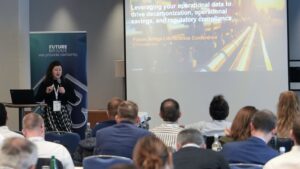For corporations worldwide, Scope 3 emissions present the most complex piece of the climate puzzle. As indirect impacts from activities like raw material production, business travel, and product disposal, Scope 3 occurs outside a company’s operations. While these emissions compose the majority of total corporate footprints, their dispersed nature across murky supply chains makes Scope 3 arduous. This is to accurately measure and report. Consequently, climate strategies often focus on the tip of the emissions iceberg while the submerged bulk stays obscure.
However, new technological advances are poised to illuminate this crucial blind spot. It is all set to unlock unprecedented Scope 3 insights. Moreover, cutting-edge solutions in sensors, satellites, blockchain, artificial intelligence, and cloud software are enabling automated identification, quantification, and Scope 3 reporting of emissions. So, this article explores how leading-edge technologies can shine a light on the greatest, yet obscure, share of corporate carbon impacts.
The Imperative for Scope 3 Visibility
With the urgency of climate action undisputed, enterprises face escalating pressures. It arises from governments, investors, and consumers. This is to decarbonize their full value chains, not just direct operations. Furthermore, regulations like the EU’s Corporate Sustainability Reporting Directive are making robust Scope 3 reporting or disclosures mandatory. That too for thousands of large companies. So, to meet stakeholder expectations and comply with emerging regulations, an accurate accounting of Scope 3 impacts is essential.
Yet current scope 3 reporting manually is largely futile. This is given emissions are scattered across complex, multi-tier supply chains spanning the globe. According to CDP, only 35% of firms conduct supplier engagement on emission reduction targets. Moreover, just 25% have fully mapped their value chain climate impact.
Furthermore, technologies like geo-analytics, blockchain, AI, and product lifecycle analysis can pierce through current limitations. This is to provide the missing visibility into these opaque impacts.
For example. blockchain allows the tracing of material flows across suppliers globally. This is to pinpoint emissions hotspots. Moreover, geo-analytics can map the precise location of contract manufacturing plants, distribution hubs, and raw material sources. This is to target high-impact areas. Additionally, algorithms rapidly analyze disjointed data from myriad sources. It reveals carbon reduction priorities across the value chain.
Where supplier emissions data has gaps, AI modeling provides robust estimates. This is based on expenditure, commodity benchmarks, and geographic emission factors. Moreover, digital twins capture product usage emissions beyond manufacturing. This makes the long-asked question of what are the technologies for scope 3 reporting clear.
With Scope 3 illuminated, companies gain an accurate compass. It guides enterprise-wide value chain decarbonization. It is based on actual insights rather than assumptions. Additionally, cross-functional teams can collaboratively develop solutions. This is to materially reduce emissions based on a complete picture.
Automating Scope 3 Reporting: The Carbon Accounting Revolution
Scope 3 reporting technology is enabling a transition akin to financial reporting’s evolution. This is from siloed ledgers to integrated enterprise systems.
In the past, scope 3 accounting was performed manually in departmental silos. It relied on paper records. Furthermore, companies lacked unified data platforms. Moreover, carbon accounting processes were disjointed across functions. Additionally, emissions were calculated periodically through cumbersome, inconsistent manual approaches prone to inaccuracies.
Reporting provided infrequent retrospective snapshots of emissions, often only on an annual basis. Analysis was also constrained since consolidating data from diverse sources and business units was extremely difficult without digitalization.
In contrast, today’s solutions allow continuous, automated consolidation of standardized Scope 3 data. This is onto cloud-based enterprise platforms. Furthermore, seamless system integrations enable unified insights and coordination across departments. So, regular algorithms enhance the accuracy and consistency of emissions calculations. Moreover, real-time analytics provide predictive modeling capabilities. This is to support scenarios and planning. Interactive visualizations empower the dynamic exploration of emissions data. It comes from multiple dimensions to uncover trends and opportunities.
Overall, technology is enabling rapid, accurate, and interconnected Scope 3 tracking far beyond current capabilities. So, this new world of accounting integration is empowering climate action based on holistic value chain insights.
Automating Scope 3 Reporting: Fundamental Platform Capabilities
To effectively illuminate Scope 3 emissions, automation solutions should encompass these fundamental capabilities:
Data Consolidation
Scope 3 data is enormously varied in format, spanning sensors, invoices, surveys, and life cycle studies. Furthermore, technology should ingest and standardize this varied information. It should be into consistent emissions categories. Moreover, it should map data from disparate systems into a unified structure. It should also continually enhance data points over time for completeness.
Calculation
With data consolidated, automated methodologies can apply accurate emissions factors and formulas consistently. They can quantify historical emissions. It identifies trends and patterns and models future projections and reduction scenarios aligned with climate science.
Supply Chain Transparency
Tracking emissions across complex, global supply chains requires technology. This is to visually map upstream and downstream value chain nodes and impacts. So, it should provide real-time monitoring of supplier and distribution emissions. Moreover, it should verify reported data independently through audits.
Insights Discovery
To guide effective strategies, automation enables pinpointing hotspots. This is by emissions category, supplier, facility, and geography. Furthermore, it allows for the identification of correlations, trends, and drivers. It takes place through analytics and forecasting future emissions based on operational plans and scenarios.
Compliance Reporting
Automating reporting streamlines populating disclosures in required formats. It is for standards like CDSB, CDP, and GRI. Furthermore, it enables continual alignment with evolving regulations like SEC rules and CSRD. Moreover, it enables adapting to emerging carbon labeling mandates.
Interface and Visualization
Intuitive access to data enables interactive charts, graphs, and dashboards. It explores datasets and drill-down reporting by category, business unit, or emission source. It also allows custom reporting tailored for diverse internal and external stakeholders.
Collaboration
As Scope 3 spans the enterprise, technology can enable coordinating surveys, data requests, and corrective actions across functions and suppliers. Furthermore, it allows workflow management for engaging partners and central documentation storage.
With these comprehensive capabilities, Scope 3 technology can uncover the greatest climate impacts. It can also empower science-aligned value chain decarbonization.
Automating Scope 3 Report: Strategic Implementation
Now that we know what are the technologies for Scope 3 reporting, simply deploying Scope 3 technology tools will not automatically lead to success. So, companies require a strategic approach:
Starting with a multi-year technology plan allows structured implementation aligned to overarching decarbonization goals. Moreover, an incremental rollout focused on top emission sources enables controlled scaling.
Providing training on carbon accounting is helpful. It engages teams like procurement and suppliers. Additionally, integrating systems into existing workflows improves adoption. Incentives can encourage partners to share quality data.
Initially, technology efforts should focus on capturing accurate and complete primary emissions data. This is from partners through surveys, IoT sensors, and audits. Estimation can supplement gaps later as capabilities advance.
Furthermore, the technology must go beyond reporting for compliance. Teams should be enabled to continuously identify hotspots, trends, and insights to pursue targeted value chain improvements.
Regular software updates enable maintaining alignment with evolving disclosure regulations, standards, and stakeholder needs.
The Future of Scope 3 Reporting: Real-Time Value Chain Guidance System
Big companies like Microsoft, Amazon, Maersk, and Nintendo are using new technology to measure how much their actions affect the environment (Scope 3 measurement automation). The results are good – Walmart, for example, can report its environmental impact 70% faster. As technology gets better, managing and reducing environmental impact will become a quick, real-time digital system that helps the whole company become more eco-friendly.
Imagine using a navigation system to plan a trip – it shows the way, but you still need someone to drive. In the same way, using technology to be more sustainable needs commitment and action from company leaders. They need to make being eco-friendly a part of how the company works.
Scope 3 data will show how much a company affects the climate. With this information, leaders can make changes to move towards a more eco-friendly way of doing business in a net-zero economy.
To learn more about Scope 3 reporting standards, emerging technologies, and reduction strategies, sustainability professionals should attend the 2nd Global Scope 3 Emissions Reduction Summit on April 18-19, 2024 in Berlin, Germany. The flagship event convenes experts to explore legislative contexts, data collection methodologies, disclosure frameworks, and leveraging automation for supply chain transparency and reductions.
Through panels, case studies, and interactive sessions, attendees can gain insights to accelerate their organization’s Scope 3 capabilities and net zero progress. With regulation and stakeholder pressures intensifying, now is the time to get ahead and unveil currently obscured value chain climate impacts.




